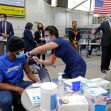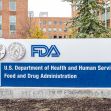Since December, the United States has been slowly rolling out vaccines across states and territories. There have been 95.7 million doses administered with a rough estimate of 2.17 million doses administered per day. The United States has reached a point where it has vaccinated more people than those having tested positive, but unfortunately, there is still confusion over who is a priority to get the vaccine first and when.
As of March 10, 2021, over 123,232,775 doses have been delivered to states and territories across the United States, and of those 93,692,598 doses have actually been administered to individuals, roughly 76% of the vaccines. Of those used, 9.7% of the U.S. population has been fully vaccinated, while 18.4% have received at least one dose of an approved vaccine.
On December 11, 2020, the U.S. Food and Drug Administration (FDA) approved Pfizer-BioNTech’s drug as the first COVID-19 vaccine for Emergency Use Authorization (EUA) in the United States. Just one week later, Moderna also received a EUA for its COVID-19 vaccine. And most recently, on February 27th, a single-shot vaccine from Johnson & Johnson was issued a EUA by the FDA.
Under the Trump Administration’s Operation Warp Speed, federal administrators were tasked with creating a process to divide vaccines out equally nationwide. Under the Operation, an automated algorithm was devised based on a state’s adult population alone.
States receive weekly quotas from all approved vaccines and then are tasked with developing their plans for disseminating the vaccines across their counties and cities. The Centers for Disease Control and Protection (CDC) has a list of recommendations to guide states in devising tiered rollout plans to targeted populations, but it is not followed uniformly across states, nor can it be enforced by federal regulation.
After the FDA authorizes or approves a vaccine, the Advisor Committee on Immunization Practices (ACIP) holds a public meeting to make recommendations to states on who should receive the vaccine first, especially when there is a limited supply. Before they make a recommendation, ACIP reviews the data on the trials of each vaccine including side effects based on age, gender, or health condition.
So far, ACIP has devised a three-tiered plan for prioritized populations. Phase 1a includes health care personnel and long-term care facility residents. Phase 1b expands on the previous group to include people aged 75 and older and non-healthcare frontline essential workers when there is a sufficient supply of the vaccine for a state. And lastly, ACIP has recommended Phase 1c to include people aged 65 to 74 years old, individuals aged 16 to 64 with high-risk medical conditions, and essential workers not included in Phase 1b. On March 2, 2021, the Acting Secretary for the Department of Health and Human Services directed states that teachers, school staff, and childcare workers be eligible for the COVID-19 vaccine, regardless of where each state was in their phase approach of vaccine rollouts.
Unfortunately, there has been mass confusion and misinformation as states are responsible for developing their rollout plans. Some states like Oregon prioritized teachers over the elderly, but New Jersey has put smokers in front of educators in the line to receive the COVID-19 vaccine, for example.
In the CDC’s recommended rollout phasing, there is little direct guidance other than age groups. For instance, conditions that qualify for “high-risk” vaccine prioritization varies from state to state. In California, they only consider 10 of the CDC’s high-risk conditions in their vaccine rollout plan. There is no unified definition of health conditions that every state qualifies as a health condition requiring a vaccine first.
Currently, some in states like California, Connecticut, and Indiana, where they once had considered disability and health conditions a priority, are now pivoting to an age-based strategy, leaving behind those with health conditions that are of younger generations. These loopholes, while slowly being filled, are still a liability for many that have health conditions restricting their movement through society.
Inherently, with the difference in rollout plans, some states are more efficient at vaccinating their population than others. Alaska has the most fully vaccinated individuals of any state or territory, with over 16%. However, this statistic is misleading since their population currently accounts for only 731,545. In comparison, California, with well over 39 million residents, has already administered at least one dose to 18.7% of the population and fully vaccinated 8.7%.
A class-action lawsuit was filed in Nevada on January 11, 2021. It alleges that the state vaccine rollout plan “denied the protected group of individuals access to the COVID-19 vaccines in an arbitrary and capricious manner.” Pointing to the low vaccine rate compared to the number of vaccines allocated to the state, those represented by the group are over the age of 70 and have yet to have any of the COVID-19 vaccines allocated to the state which received its first doses of the Pfizer-BioNTech and Moderna vaccines on December 15, 2020.
The lawsuit claims that the actions taken by the state of Nevada are a violation of the injured party’s constitutional rights. First, the plaintiffs argue that the state’s vaccination plan denies them “Due Process and Equal Protection under the Fifth and Fourteenth Amendments.” Additionally, they claim that they were deprived of their “rights against Cruel and Unusual Punishment under the Eighth Amendment.”
Since the lawsuit was filed, the Governor of Nevada, Steve Sisolak, unveiled a new system for vaccination, allowing a “new lane” in Nevada’s “Vaccination Playbook” for people to receive the vaccine quicker. The lawsuit, however, is still pending.
This confusion and ethical question over who should get the vaccines first has led to vaccines going to waste in some states, while in other states, individuals are receiving the vaccine simply because they were in the right place at the right time. While wasted vaccines have largely been controlled and most states have reached a steady, equal rollout process, there are still some states that are outliers where many claim the systems are inefficient and unfair.






